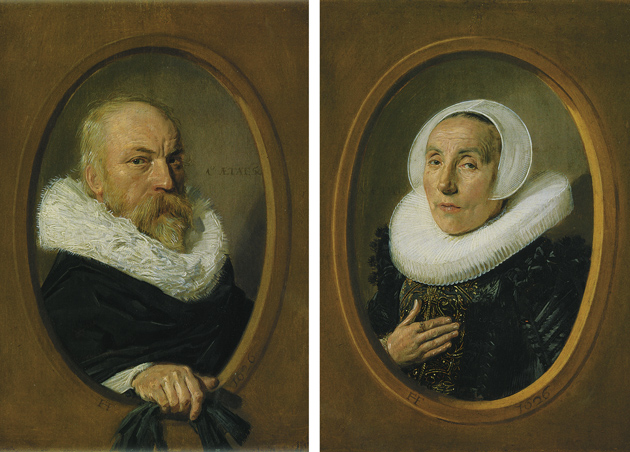The Metropolitan Museum has had the fine idea of bringing together the eleven paintings in its collection by Frans Hals (1582/3–1666), along with two Halses in private collections, to form what appears to be, while hardly a true survey, the first concentrated look at this wonderful artist that New York has had. Judged next to the full-dress Hals retrospective held at the National Gallery in Washington in 1989, however, the Met’s show could stand some sparks. It doesn’t clearly and powerfully demonstrate what makes the painter significant.
As Thomas P. Campbell, the Met’s director, notes in the preface to the small catalog accompanying the exhibition, for years one would see a large overhead directional sign at the Rijksmuseum in Amsterdam that said “Hals—Rembrandt—Vermeer”—meaning, in effect, that Hals was one of the cornerstones of the great era of Dutch painting. For those of us who love his work—and I think he is an artist you love rather than admire—that sign (which apparently has come down) made perfect sense. Hals provides something huge that we don’t get in Rembrandt or Vermeer and that complements them: a quicksilver and empathic responsiveness to people in all their variety.
In a career that lasted some five decades, Hals was always in essence a portraitist. He painted the very wealthy and the burghers and their families of his home base, Haarlem, as well as clergymen, actors, artists, and historians. His sitters included the occasional wild card (such as a witch-like inmate of a house of correction), and he was the first Dutch artist to make working-class boys and girls, who we see smiling, sometimes still on their jobs, the subjects of paintings. Hals made monumentally large group portraits of Haarlem’s civic guards, outfitted in their resplendent military finery, and of the regents of a hospital sitting around a table, wearing sober black and white. The artist’s last group portraits, of the male and female regents of the Old Men’s Almshouse, which are justly renowned for their array of penetrating and reflective faces, some of them old and frail looking, were done in the 1660s, when the artist was in his eighties.
Hals was a painter of instantaneity, of the secular, everyday here and now. He delineates the second when, cast in a precise but never excessive or dramatizing light, a portrait subject comes before us as a breathing character, someone we think we know a little. It is Hals’s feeling for the singular moment, person, and degree of illumination that sets him apart from his peers as a portraitist—whether those who came before him (such as Holbein or Giovanni Battista Moroni in the sixteenth century), or were his contemporaries in Holland and elsewhere (such as Rembrandt, van Dyck, Rubens, or Velázquez), or came later (such as Reynolds and Gainsborough in the eighteenth century and Ingres and Thomas Lawrence in the early nineteenth century).
Hals’s pictures aren’t psychological. The children and the young and middle-aged men and women he painted are rarely seen in states of inwardness or emotional ambiguity. It is true that two of the men seem to have drifted off in his painting of the regents of the Almshouse (which is not in the show but can be seen in the Met’s catalog). More than that, their faces are peerless examples of what it looks like to be lost in thought. But the picture of the regents is an exception. Hals’s people in general are not preoccupied. They make eye contact with us, and when they don’t it is because they appear to be looking at a particular thing offstage.
Some of Hals’s most extraordinary pictures are about the way people look at, or away from, one another. In large-size paintings done at different times in his life of couples and of parents sitting with their children, he proved himself to be a sure-handed, even dazzling, dramatist. In a family group scene in Madrid’s Museo Thyssen-Bornemisza (which can also be found in the Met’s catalog but not in its show), a husband and wife exchange wary, knowing, and, perhaps, trusting gazes at one another. The work is a kind of monument to that valuable and fragile tool of couples called “truce.” Hals shows another couple (in a work in the Rijksmuseum) at a moment when he and she each looks out at Hals, or us, their faces perfectly expressing the bantering affectionateness that can exist between two people.
Hals was an unusual artist in that, especially in the first half of his career, he was able to paint, with little or no coyness, people grinning, or being plain happy. The relative scarcity in the history of painting of people giggling or looking like they have just said or heard something tickling indicates how hard it must be for a painter to bring off such a thing. Hals’s images of laughter and mirth come across as being the underpinning of his approach. It is as if his work is based on a philosophical position, and he is saying, “We are alive, so how can we not be cheerful?”
Advertisement
Far from all his people are effervescent. He was hardly a painter propounding a thesis. As Seymour Slive, our foremost authority on the artist, has suggested, Hals seems to have taken the key to each of his pictures from the nature of his encounter with the sitter. (Slive’s writings on Hals have the same warmth, directness, energy, and clarity that rise from the paintings.) The experience of the 1989 retrospective, which was largely Slive’s work and which can almost be recaptured in its catalog, where the reproductions are large and good, is that we are encountering a storehouse of subtle moods and expressions.
We see people who are, from painting to painting, alert, bemused, shy, in the middle of a remark, or mildly questioning. This one looks out at us appraisingly. One or two sitters feel like phonies or rakes, and we of course are drawn to them the most. Many are expressively neutral, but hardly one is inert. The cumulative effect of these many separate persons is that we know Hals himself. He is the generous, genial, and shrewd man, we tell ourselves, who has been able to capture them all.
This notion is fed by the no more than rudimentary nature of the existing biographical facts about him. Hals left no statements about his work. He was humbly born, married twice, and the father of many children. He was a member of Haarlem’s civic and art organizations, and played no noteworthy role in either. He clearly could hold his own facing figures of high social standing, intellectuals—most significantly Descartes, whose portrait is in the Statens Museum for Kunst, Copenhagen—and street people. In a rare anecdote, he bought a painting at auction and found that he didn’t have enough to pay for it. Money was always an issue. He was frequently in debt and in his last years he needed to ask the city for assistance more than once.
The Met’s small exhibition, in which one room is occupied by pictures by artists whose work has some bearing on Hals, is not ideal for viewers coming to him for the first time. It lacks any of his large group scenes, his pictures of couples or families, or his portraits of foppish or vaguely dissolute young men about town. It does, however, include two pictures that tell us a lot about how Hals came into his own. They are Merrymakers at Shrovetide and Young Man and Woman in an Inn—both extremely close-up views, done relatively early in his career, of hearty celebrants. They are more believable and muscular than most Dutch paintings of animal high spirits (including the young Rembrandt’s versions). But their chief interest, as Slive has inferred, is the way they show Hals educating himself. You see him transmuting their profane spirit, with the sweaty joviality burned off, into the portraits.
The partytime pictures pale next to a mature masterpiece: a portrait of a nearly forty-year-old brewer named Duyst van Voorhout. The trace of condescension with which this citizen, with his large hat and carefully balanced units of facial hair, looks out at us—combined with a note of incipient blubbery ridiculousness that we also see in him—makes him, as a character, irresistible. The roughly eight-inch-high portraits of a wary Anna van de Aar and her vigilant white-haired writer husband, Petrus Scriverius (who recalls the fierce old Henry Adams as seen in photographs), are also standouts. Working as virtually a miniaturist, Hals lost nothing of his incisiveness about people—or his ability to be sparklingly light-filled in his color and dexterous in his brushwork.
With its sense of speediness and immediacy, Hals’s brushwork is of a piece with his view of people. It is a good part of what excited later nineteenth-century French painters and writers about his work, which for some two centuries after his death was overlooked precisely because of the artist’s seemingly too informal approach. What to us is deliciously transparent and light-catching about his brush marks felt “unfinished” to audiences before the 1880s or so.
What may also have contributed to the public’s losing sight of Hals for so long lies in the very nature of portraits. Walter Liedtke, the Met curator who organized the show, notes in his cogent and witty catalog essay that portraits were traditionally recorded in inventories by the name of the sitter, not the painter. The practice, which conceivably resulted in pictures disappearing because the sitters had become unknown over time, may at least help explain why Hals’s extant body of paintings is small. It numbers less than 250 examples (and not a single drawing or print has been found).
Advertisement
Hals the painter is the perfect foil to Rembrandt the painter. Rembrandt, who was twenty-five years younger, creates a realm where colors (and the meanings of his pictures) seem to be emerging and subsiding at the same time. We look at paint surfaces where zones of a literally crunchy golden radiance hold off areas of a velvety brown darkness. The surfaces of Hals’s pictures don’t convey that density, and the colors we most associate with him are black, white, and gray. They are simply the colors of the clothes many of his people wear. To get up close to the portrait of Duyst van Voorhout, much of which is comprised of the portly man’s outfit, is to become pleasurably enveloped in a glinting, silvery expanse of dashes and slashes that conveys sheer freedom as much as it does pinpoint control. Hals, who had no feeling for mystery or grand ambiguities, lets seemingly every darting stroke of paint speak up for itself.




